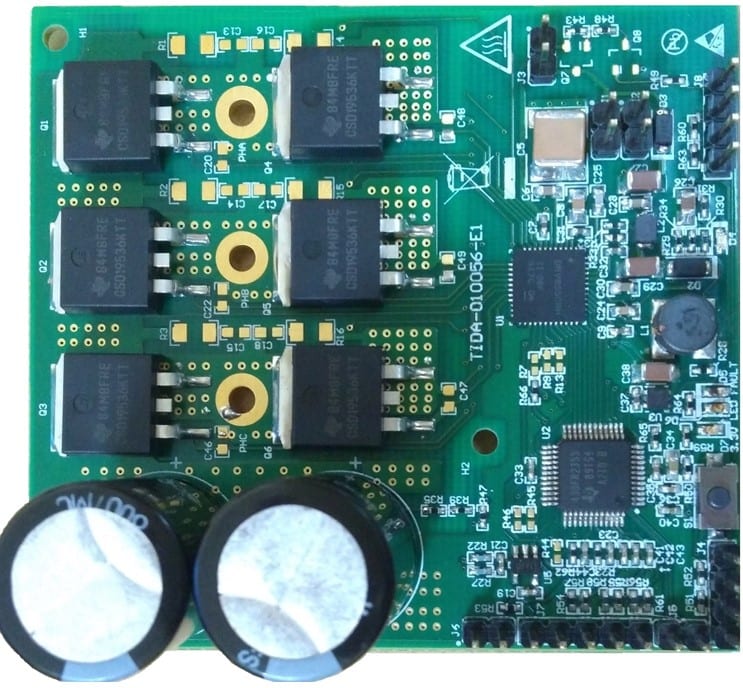54V, 1.5kW, >99% Efficient 3-Phase BLDC Drive Reference Design
The TIDA-010056 reference design from Texas Instruments demonstrates a 1.5kW power stage for driving a three-phase brushless dc motor in cordless tools, e-bikes or lawn mowers operating from a 15-cell Li-ion battery with a voltage up to 63V. The design is a 70mm x 69mm compact drive, bringing 25A RMS continuous current at 20kHz switching frequency without heat sink and with natural convection, implementing sensor-based trapezoidal control. The design achieves optimized MOSFET switching loss and EMI by using a smart gate driver with optimized MOSFET and PCB.
The design shows MOSFET operation within the safe operating area using enhanced protections including MOSFET over current and shoot-through protection by VDS monitoring, gate protection, switching voltage spike optimization with slew rate control and over temperature protection.
Design Considerations
- Three-phase power stage including gate drivers and FETs
- Motor position sensor (three hall latches) interface for sensored trapezoidal control
- DC bus voltage sensing and all the three-phase node voltage sensing circuit to implement sensorless trapezoidal control
- DC bus low side current sensing for torque control and software current limit by MCU
- Board power supply generation including 15V and 3.3V from the 54V line
- MOSFET temperature sensing using on board temperature sensor
- Host controller to implement the necessary motor control algorithms, sensing and protections
 TIDA-010056 54-V, 1.5 kW, >99% Efficient, 70x69 mm2 power stage reference design for 3-phase BLDC drives board image
TIDA-010056 54-V, 1.5 kW, >99% Efficient, 70x69 mm2 power stage reference design for 3-phase BLDC drives board image
Summary of Design Features
- Operates at voltage ranging from 9V to 63V (15s li-ion battery) delivering 25ARMS continuous current, 400A peak
- 54V/1.5kW, 25A RMS support without heat sink in a small 70mm x 69mm PCB form factor
- Designed to support both sensored and sensorless trapezoidal control
- More than 99% efficiency at 54V/1.5kW for 20kHz unipolar trapezoidal control
- MOSFET over current protection by VDS sensing with response time less than 1µs with additional 4µs deglitch time to eliminate false trips
- Enhanced protection at MOSFET gate including VGS under-voltage, over-voltage, gate to source short circuit and open circuit protections
- Operating ambient: -20°C to 55°C
Background and System Description
Cordless tools use brushed or brushless dc (BLDC) motors. The BLDC motors are more efficient and have less maintenance, low noise, and longer life. Power tools have requirements on form factor, efficiency, peak current, reliability, and thermal performance. Therefore, high-efficient power stages with a compact size are required to drive the power tool motor. The small form factor of the power stage enables flexible mounting, better PCB layout performance, and low-cost design.
High efficiency provides maximum battery duration and reduces cooling efforts. The high-efficiency requirement in turn asks for switching devices with a low drain-to-source resistance (RDS_ON). The power stage must also take care of protections like motor stall or any other chances of high current.
This reference design uses the CSD19536KTT NexFET™ featuring a very low RDS_ON of 2mΩ in D2PAK package with an optimized gate charge and switching performance. The three-phase gate driver DRV8350R is used to drive the three-phase MOSFET bridge, which can operate from 9V to 100V and support programmable gate current with maximum setting of 2A sink / 1A source. The DRV8350R uses smart gate drive (SGD) architecture to decrease the number of external components that are typically necessary for MOSFET slew rate control and protection circuits. The DRV8350R devices integrate a 350mA buck regulator.
The INA180A3 integrated current sense amplifier is used to sense the low side dc bus current, at a gain of 100V/V with very low gain error. The TMP235 temperature sensor is used to sense the FET temperature. The MSP430FR2355 microcontroller is used to implement the control algorithm. The design has motor back emf sensing circuits and dc bus voltage sensing circuit for sensorless control using the smart analog combo of MSP430FR2355.






